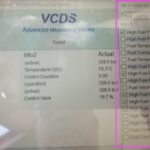VCDS (Vag-Com Diagnostic System) is a powerful software tool used for in-depth diagnostics and troubleshooting of Volkswagen, Audi, Seat, and Skoda vehicles. The VCDS auto scan function allows users to quickly and efficiently scan all the control modules in a vehicle, retrieving valuable information such as fault codes, part numbers, and software coding. This article provides a comprehensive guide on how to perform a VCDS auto scan and interpret the results. Download the latest version of VCDS for comprehensive vehicle diagnostics.
Understanding the VCDS Auto Scan
The VCDS auto scan systematically interrogates each control module within the vehicle’s network. This process gathers crucial data that can pinpoint the root cause of malfunctions and aid in efficient repairs. The data collected includes:
- Fault Codes (DTCs): These codes indicate specific problems detected by the control modules.
- Part Numbers: Identify the specific hardware components installed in the vehicle.
- Component Numbers: Provide further details about individual components within a module.
- Software Coding: Reveals the specific software version running on each module.
- WSC (Workshop Code): Identifies the workshop or dealership that last performed service.
Performing a VCDS Auto Scan
Before initiating an auto scan, selecting the correct Chassis Type is crucial. This ensures VCDS only scans for modules relevant to the specific vehicle model. The Chassis Type is typically the 7th and 8th digits of the VIN. For newer CAN-based vehicles, selecting “Auto Detect (CAN Only)” allows VCDS to automatically determine the installed modules, significantly speeding up the scanning process.
Key Features and Options:
- UDS Aggressive Mode: This mode attempts to retrieve all fault codes, including those not typically displayed by factory scan tools.
- Display Freeze Frame Data: Includes freeze frame data for fault codes on supported modules, providing valuable context about the conditions when the fault occurred.
- MyAutoScan.TXT: Allows customization of the auto scan process for specific vehicles by creating custom profiles.
Interpreting Auto Scan Results
During the scan, VCDS cycles through the Open Controller and Fault Codes screens for each module. The results display information such as:
- Hardware and Software Part Numbers: Identify the specific versions of hardware and software installed.
- ROD Files (UDS Modules): Indicate the relevant data files used for UDS (Unified Diagnostic Services) communication.
- Label Files: Provide descriptive information about the functions of each module. Special characters before label files indicate the type of coding available:
*: Experimental Coding.: Coding from the Label File|: Both Coding from the Label File and Experimental Coding
Double-clicking on any module highlighted in red after the scan directly opens the Fault Codes screen for that module, facilitating further diagnostics and code clearing. You can copy, print, or save the complete auto scan results for future reference. The saved file will be located in the VCDSLogs directory. While VCDS automatically saves scans, it’s recommended to back up these files to prevent data loss.
Clearing Fault Codes
VCDS offers several ways to clear fault codes:
- Double-Clicking Red Modules: Clears codes for the specific module.
- Clear All DTCs Function: Clears codes from all modules simultaneously, particularly efficient for CAN-based vehicles. This requires a HEX Interface.
Conclusion
The VCDS auto scan provides a comprehensive overview of a vehicle’s electronic systems. By understanding how to perform and interpret the results, users can efficiently diagnose and resolve vehicle issues. Downloading the latest version of VCDS ensures access to the most up-to-date features and functionalities for accurate and efficient vehicle diagnostics. Remember to consult the official Ross-Tech website for detailed documentation and support.


